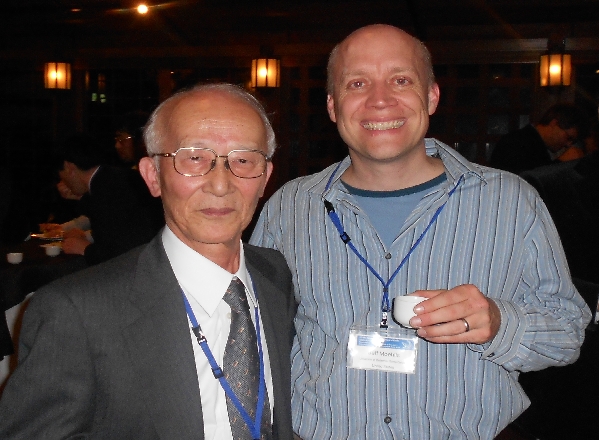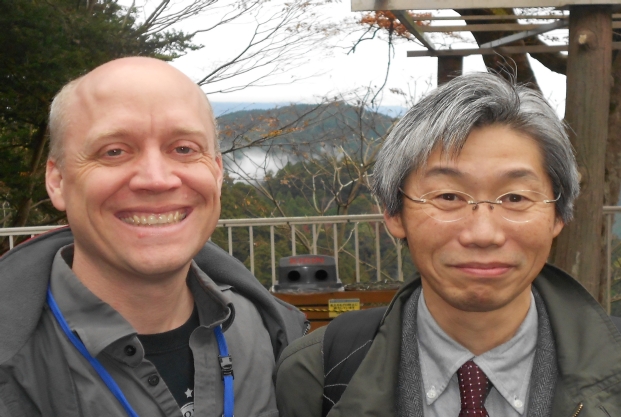On November 27, 1961, Yoshisuke Ueda, then a graduate student in the
Department of Electrical Engineering at Kyoto University, was mapping
the entrainment boundary for a periodically forced nonlinear ordinary
differential equation using an analog computer. When he varied a
parameter, he discovered that the solution suddenly changed from being
periodic to what he later termed a "randomly transitional phenomenon",
a nicely descriptive phrase for what is now commonly known as
"chaos". When he plotted the data using a once-per-forcing-period
stroboscopic map, the points fell on a shape that reminded Ueda of the
jagged edges of a broken eggshell. Ueda's discovery went unpublished
for years because his advisor did not believe the results, but it is
now recognized as one of the first experimental observations of chaos.

Kyoto was bursting with color during the symposium, shown here at
Daitoku-ji..
Almost exactly 50 years later and approximately 150 meters from the site
of Ueda's discovery, the IUTAM Symposium on 50 Years of Chaos: Applied
and Theoretical
was held from November 28 - December 2, 2011 at Kyoto University. It
was a true delight that
Yoshisuke Ueda, now
an Emeritus Professor of Kyoto University and an Invited Research
Scientist at Waseda University, gave a keynote presentation on this
and his subsequent investigations into chaotic phenomena, including
many vintage photos and tributes to people he interacted with over
the years. He even expressed gratitude that his advisor didn't latch
onto his discovery, because that meant that Professor Ueda ultimately
received full credit for it.
There were also wonderful keynote presentations by other important
figures in the study of chaos.
Philip Holmes
from Princeton University covered an amazing amount of dynamical
systems history in his talk, including the story of Henri Poincare's
"solution" to the three body problem, for which he was awarded a
significant prize by King Oscar II of Sweden and Norway. When
Poincare's paper was being prepared for publication, however, copy
editor Lars Edvard Phragmen commented that several parts were unclear,
and as Poincare wrote additional explanations, he realized that he had
in fact made a mistake. In resolving it, Poincare showed, in today's
language, that chaos exists for this problem. Holmes also told the
stories of annulus maps, the horseshoe map, nonlinear oscillations,
and parallel developments such as KAM theory, ultimately arguing quite
convincingly for the importance of considering simple, abstract
models to get insight into complicated phenomena.

The author with Professor Yoshisuke Ueda at the Symposium Banquet..
Frank Moon,
recently retired from Cornell University, told of his latest efforts
to develop vibro-wind energy scavengers to capture wind energy in urban
environments, for which windmills are impractical. The design that
his team is converging to involves hundreds of blunt body oscillators
that would be mounted on a building's facade. Moon also reminisced
about the work on chaos that had been done over the last decades
at Cornell, concluding that "science is not done by geniuses, it's
done by people talking to each other."
David Ruelle from the
Institut des Hautes Etudes Scientifiques, just south of Paris,
amusingly started his presentation wearing a surgical mask, a
somewhat common sight in Kyoto where some residents use them
to try to stay healthy. He then proceeded to give his reflections on
the history and future of chaos, including the "extremely exciting"
period in the 1970's and 1980's when he and many others made
fundamental contributions, and recent efforts to connect chaos with
nonequilibrium statistical mechanics.
Jim Yorke from the University
of Maryland gave a presentation on the "facets of chaos", a "more
polished" version of the talk that he gave for the Juergen Moser
Lecture [https://client.blueskybroadcast.com/SIAM11/DS/siam_IP0/]
at the 2011 SIAM Conference on Applications of Dynamical Systems in
Snowbird, Utah. Using the analogy of the story of the blind men and
the elephant
, he argued
that "if you only know one aspect of chaos, you don't understand
chaos". The facets he identified included a positive Lyapunov
exponent, a broadband power spectrum, period doubling cascades,
statistical regularity, and many other phenomena that chaos
connoisseurs including myself find so fascinating.
There were also many contributed talks and posters from a truly
worldwide set of chaos researchers, with apologies to those that
aren't named below in the interest of space.
Of course, given the location, Japan was very well represented by
people like Kazuyuki Aihara (University of Tokyo) who told of
applications of chaos in household appliances and fashion, Hiroaki
Daido (Osaka Prefecture University) who talked about some of his
latest work on coupled oscillators, and Hiroya Nakao (Tokyo Institute
of Technology) who described how phase descriptions can be defined for
periodic solutions in reaction-diffusion systems.

The author with Professor Takashi Hikihara, the Chair of the Organizing
Committee for the symposium, after we rode the cable car to Enryakuji..
A sampling of presenters from elsewhere in the world includes Walter
Lacarbonara (Italy), Bruno Eckhardt (Germany), Oded Gottlieb (Israel),
Antonio Palacios, Sri Namachchivaya, Predrag Cvitanovic (United
States), and Tomasz Kapitaniak (Poland) who gave an informative and
highly entertaining talk on whether a dice roll is chaotic or random.
The Proceedings of the Symposium will be published very shortly in
the Elsevier proceedings series IUTAM Procedia, to be edited by Takashi
Hikihara
(Kyoto University) and Tsutomu Kambe
(University of Tokyo). Also, a Focus Issue of the AIP journal Chaos
called "Fifty Years of Chaos: Applied and Theoretical", comprising
invited papers from contributors to the symposium, is in preparation,
to be edited by Giuseppe Rega (Universita degli Studi di Roma "La
Sapienza"), Takashi Hikihara, Tsutomu Kambe, and Philip Holmes.
There were also several fun social events built into the program. On
the first day, while many of us were still adjusting to the time
change, there was a Welcome Reception with delicious food and drink.
(Afterwards I somehow had the energy to visit the underground Metro
music club, and almost convinced an exhausted attendee from Europe to
join me, but he was spooked by the loud music.) A conference highlight
was the Symposium Banquet at The Garden Oriental Kyoto in Gion, which
is the Geisha district of Kyoto. There were heartfelt tributes to
Professor Ueda and others given by the keynote speakers, one of whom I
enjoyed sharing a warm bottle of sake with. (The sake continued to
flow later that night when I hit the town with some fellow symposium
attendees who shall remain nameless.) And after the talks ended on
the last day, there was an organized excursion via bus and cable car
to the amazing temples at Enryakuji.
Kudos must be given to the Organizing Committee, including Takashi
Hikihara who served as the Chair, Tsutomu Kambe who served as
Co-Chair, and Yoshihiko Susuki and Nobuo Satoh (Kyoto University) who
served as the General Secretaries. Overall, the conference was
superbly organized and had stellar presentations in a location that is
both beautiful and important in the history of chaos, the latter
thanks to the experimental observation of chaos by Professor Ueda so
many years ago.
The author would like to thank Professors Philip Holmes, Takashi
Hikihara, and Yoshihiko Susuki for comments on this article.
Jeff Moehlis